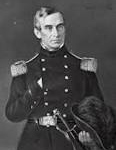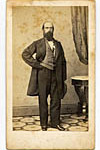Love, Loyalty, and Robert Anderson
Eliza Clinch Anderson knew when her husband, Major Robert Anderson, was ordered to report to Fort Moultrie on November 15, 1860, that he had been given the toughest job in the United States Army: Maintaining the defensive positions in Charleston Harbor without provoking conflict with the state of South Carolina, which was threatening to withdraw from the Union following Abraham Lincoln’s election as president the previous week. In the event of secession, South Carolina would ask that all Federal government facilities in Charleston and the harbor be handed over to the state, something the United States would not permit.

While on furlough in New York, Major Robert Anderson was ordered to take charge of the Union defenses in Charleston Harbor just as the nation was breaking apart. Although he surrendered Fort Sumter on April 14, 1861, he became the Union’s first hero of the Civil War and was promoted to Brigadier General. The Sumter experience damaged his health and he left the army in the autumn of 1861. He died in 1871.
By early December, Eliza knew the toughest job was also dangerous. Anderson’s letters told her Moultrie’s garrison consisted of only eight officers, sixty-one soldiers, and thirteen musicians, some of whom were southern sympathizers. Additionally, numerous workmen from the city came into the fort daily to make improvements on it and were likely spies. Finally, the position of the fort, low and close to shore, left it vulnerable to attack from the mainland.
Eliza fully appreciated her husband’s precarious position. In addition to having been an army wife for eighteen years, she was the daughter of a career officer, General Duncan Clinch, and knew Anderson and his tiny garrison were sitting ducks. Also, the Georgia-born woman, still in communication with her relatives in the South, knew fire-eaters had inflamed the emotions of Charlestonians, making the city a virtual powder keg. Eliza knew her husband needed help, and she knew who was in the best position to provide it.
Early in December, Eliza traveled from New York City, where she was living in the Breevort Hotel with her four children, to Washington, D. C., to speak with her husband’s Commander-in-Chief, President James Buchanan. The President received her, listened to her plea that reinforcements be sent to Moultrie, but promised nothing. She returned to New York realizing the lame-duck president intended only to maintain the status-quo until his term ended in March, when he could palm off the crisis to Lincoln.
That Eliza Anderson made the journey to Washington and back was an amazing display of love for Robert Anderson. Eba– as she was known to her family– had been in poor health for years, and her doctor had warned her against traveling. Within a month, however, she undertook another journey of infinitely greater difficulty.
Tension at Fort Moultrie increased following South Carolina’s secession on December 20. Realizing he and his men were on their own, Major Anderson secretly moved the garrison to the more defensible but unfinished Fort Sumter on the night of December 26. Sumter could not be attacked by land, but its incomplete state necessitated continuing the use of local laborers who reported progress on the fort to the government of the now self-proclaimed sovereign state of South Carolina.
Realizing the relentless pressure placed on her husband, Eliza decided that if Buchanan would not send troops to bolster the garrison, she would send one man to bolster her husband’s spirits. She knew a man who fit the bill. What she did not know was where to find him.
During the Mexican War Anderson had developed a special rapport with his orderly, Sergeant Hart. Eliza had heard that Hart had left the Army and moved to New York. She set out to find him.

Frail Eliza Anderson ignored her doctor’s and stood up to the governor of South Carolina to bring Peter Hart to the side of her husband in Fort Sumter. She slept and ate little during her trip to Charleston, and on her way back to New York, she collapsed and had to spend several days recuperating at the Willard Hotel in Washington, D. C. Ironically, she lived until 1905.
Locating an individual in 1860 posed difficulties, but Eliza turned to the best resource she could find, the New York City directory. The 1860 U. S. census showed 813,669 people residing in the city, and a goodly number of them must have been named Hart. In The Pictorial Field Book of the Civil War in the United States, Vol. I, Benson John Lossing asserts that Eliza copied the addresses of all people named Hart and rented a carriage, determined to search until she found the former sergeant. She was fortunate in that on the second day of her effort, someone told her of a New York City policeman named Hart who had once served in the U. S. Army. Armed with that information, Eliza went to the police superintendent, ascertained that policeman Peter Hart was, indeed, the man she sought, and left a message for him to call on her at the Breevort.
Hart and his wife, whom Lossing identifies as the Andersons’ one-time cook, quickly responded. He may have been surprised when Eliza asked if he would accompany her to Fort Sumter then remain there with Major Anderson, but he immediately agreed to leave his job and family to go to Fort Sumter, reenlist, and serve at Anderson’s side. His wife concurred, and it was agreed that Hart and Eliza would depart for Charleston the following evening.
Eliza kept her plan secret from everyone but the Harts. Even her children and their nurse did not know she was going to Charleston and probably thought she was traveling south to visit family members in Georgia.
Assuming the roles of employer and servant, Eliza and Hart left New York by rail the evening of January 3, 1861. They arrived in Charleston late in the evening of January 5– too late, they were told by a station agent, to arrange for a carriage to drive them to a downtown hotel. Only after Eliza engaged in name-dropping by threatening to send a note to Governor Francis Pickens, who had been a good friend of her father, did a carriage appear.
Eliza asked to be driven to the Mills House on Market Street. She may have made the selection simply because it was a fashionable hotel, but it is more likely she knew her brother, Bayard Clinch, was there. A prominent Georgian, Clinch had come to Charleston to support secessionist activities. He drew upon his political stance and his family association with Pickens to persuade the Governor to write a pass for Eliza to enter Sumter.
However, Pickens refused to write a pass for Hart, claiming that allowing another soldier into the fort would endanger South Carolina. At this point, Eliza took matters into her own hands, arguing that upping the garrison’s strength by one man in no way threatened South Carolina– which was enrolling hundreds into its militia companies– and declaring she was taking Hart to Sumter with or without a pass. In the face of Eliza’s determination and the fallacy of his earlier reasoning, Pickens offered a compromise: Hart could remain at Sumter, provided he was not enrolled as a soldier.
Promises were given, permits were written, and passage was arranged. Around 10 a.m. on Sunday, January 6, Eliza and Hart crossed Charleston Harbor in a small boat. With them were Clinch and the Major’s brother Larz Anderson, a wealthy Ohio businessman who had come to Charleston hoping to be of help to his brother.
Two hours later, the boat returned to the mainland. An exhausted Eliza began her return journey to New York, escorted by Larz Anderson.

Peter Hart’s loyalty to the United States and to Robert Anderson was extraordinary. His bravery during the bombardment of Fort Sumter was acknowledged by all members of the garrison, and Anderson and other officers later presented him with a gold watch from Tiffany’s. Hart resumed working as a New York City policeman and died in 1892.
Back at Fort Sumter, Peter Hart enrolled into the civilian labor force as a carpenter, but he also attended Major Anderson. Lossing reports Hart carried mail to and from the mainland, where he bought “fresh provisions” for Anderson. Robert E. Denney in The Distaff Civil War says Hart was “a good scrounger and provider for his officer” until Charleston’s markets were closed to him.
Political events added to the Sumter crisis. In early February, South Carolina and six other seceded states met in Montgomery, Alabama, and formed the Confederate States of America; Texas joined on March 2, two days before Lincoln’s inauguration. War was inevitable. Anderson, Hart, and the rest of the garrison were pawns in a waiting game.
The wait ended at 4:30 the morning of April 12 when Confederates began bombarding the undermanned and outgunned fort. Anderson and his troops fought bravely, and Peter Hart earned a place in history. When hot shot fired from Fort Moultrie caused parts of Sumter to catch fire, he repeatedly led a detail of soldiers through suffocating smoke to extinguish flames threatening the fort’s powder supply.
About 1 p.m. on April 13, a Confederate ball fractured Sumter’s flagstaff, tumbling the Stars and Stripes to the ground amid smoldering debris. A lieutenant snatched the flag from the embers while Hart located a long spar and wrestled it to the parapet. Working amidst incoming fire, Hart, with the help of three soldiers, attached the flag to the spar and secured the spar to a gun carriage, thus keeping the flag aloft.
Despite this courageous act, which was cheered by the rest of the garrison, the flag would be lowered for a final time on April 14 during the ceremony following Anderson’s surrender on the previous day. Anderson folded the flag and handed it to Hart, who placed it in a bag.
Sumter was repaired and garrisoned by Confederate troops. During the war it became a frequent target of Union gunboats, but it did not come back into Federal hands until February 12, 1865. Lincoln understood the symbolic significance of the citadel as the epicenter of the start of the war and ordered that a repossession ceremony be held there on April 14, the fourth anniversary of Anderson’s surrender. That event would bring Robert Anderson, Peter Hart, and Eliza together at Fort Sumter for a second time.
At noon Anderson, now retired from military service, stood with Peter Hart, once more a New York City policeman, at his side. Eliza Anderson watched as Hart drew a scorched and battered flag from his bag and handed it to her husband to be raised and flown once again over Fort Sumter.